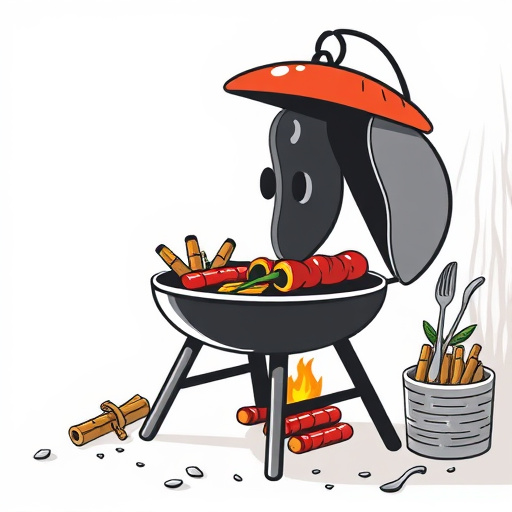Mastering the art of smoked BBQ ribs involves selecting wood types like hickory or applewood for unique flavors, using a dry rub blend to tenderize and spice meat, smoking at 225-275°F for hours, glazing with barbecue sauce or honey for a glossy finish, and serving with balanced side dishes. Crafting the perfect smoked BBQ ribs recipe enhances both taste and presentation, making it a true culinary delight.
Unleash the rich, tantalizing world of smoky flavor with our guide to crafting the perfect smoked BBQ ribs recipe. From understanding the art of smoking meats to selecting the ideal wood (oak, maple, and more), mastering dry rubs, and perfecting slow-cooking techniques, this comprehensive journey ensures every bite delivers a depth of flavor. Learn how indirect heat and low temperatures transform your ribs, and discover glaze tips for a glossy, flavorful finish. Plus, explore serving suggestions and side dish pairings to elevate your smoked BBQ ribs experience.
- Understanding Smoky Flavor: The Art of Smoking Meats
- Selecting the Right Wood for Ribs: Oak, Maple, and More
- Dry Rub: Seasoning Your Ribs Before Smoking
- Smoking Technique: Indirect Heat and Low Temperatures
- Slow Cooking: The Key to Tender, Juicy Ribs
- Glazing for Shine and Extra Flavor
- Serving Suggestions: Pairings and Side Dishes
Understanding Smoky Flavor: The Art of Smoking Meats
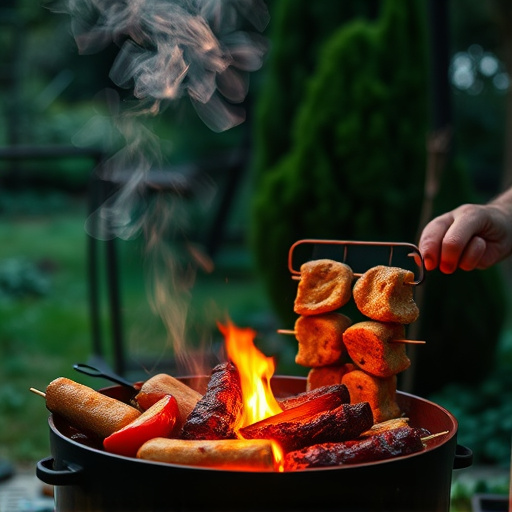
Smoky flavor is an integral part of many cuisines, especially in the beloved art of smoking meats like BBQ ribs. The process involves slowly cooking meat over wood fire or smoke, infusing it with a distinctive, rich, and sometimes intense flavor. In the case of smoked BBQ ribs recipes, this technique not only tenderizes the meat but also adds depth and complexity to each bite.
Mastering the art of smoking requires careful consideration of various factors, such as the type of wood used (e.g., hickory, oak, mesquite), cooking temperature, and duration. Each type of wood imparts a unique flavor profile, ranging from sweet and fruity to bold and pungent. For instance, hickory is known for its robust, peppery taste, while applewood provides a milder, sweeter aroma. When applied to ribs, these flavors meld with the meat’s natural juices, creating a symphony of tastes that delight the senses in every mouthwatering bite.
Selecting the Right Wood for Ribs: Oak, Maple, and More
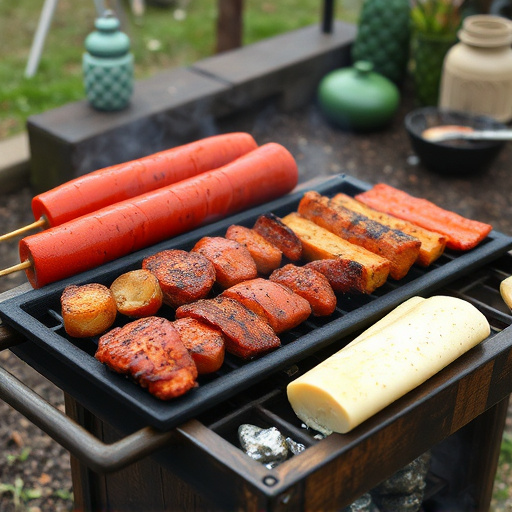
When crafting the perfect smoked BBQ ribs, selecting the right wood is a crucial step that significantly impacts the flavor profile. Different woods offer unique aromatic and taste characteristics, each adding its own twist to your ribs recipe. Oak, for instance, provides a robust, rich flavor with hints of vanilla and smoke, making it a popular choice. This versatile wood complements both beef and pork ribs equally well.
Maple, on the other hand, offers a sweeter, lighter touch. Its subtle, mild flavor enhances the natural taste of the meat without overpowering it. For a more delicate smoked BBQ ribs recipe, maple is an excellent choice. Experimenting with various woods can elevate your rib-smoking game, allowing you to create diverse and delicious flavors that cater to different palates.
Dry Rub: Seasoning Your Ribs Before Smoking
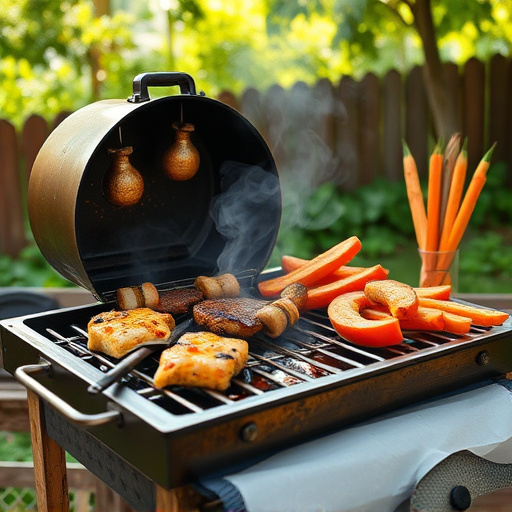
Creating smoky flavor profiles in your smoked BBQ ribs recipe starts with a dry rub—a blend of spices that enhances the meat’s natural taste while adding depth and complexity during the smoking process. Before smoking, coat your ribs generously with this aromatic mixture. The combination of salt, pepper, paprika, garlic powder, and brown sugar in the dry rub not only tenderizes the meat but also infuses it with a rich, savory flavor that permeates every bite.
The key to achieving the perfect smoky taste lies in allowing the dry rub to do its magic for at least an hour—or even overnight—to ensure the spices penetrate the meat’s fibers. This step is crucial for developing a well-rounded, robust flavor profile that will delight your taste buds. Whether you’re a seasoned smoker or just starting out, mastering this technique can elevate your smoked BBQ ribs recipe to new heights.
Smoking Technique: Indirect Heat and Low Temperatures
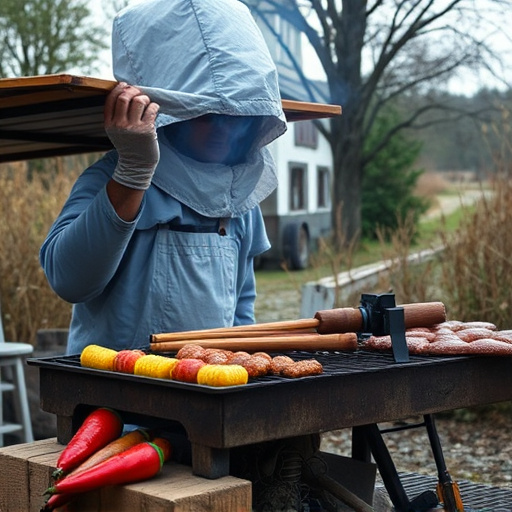
Smoking is an art that transforms ordinary meat into a delightful, smoky flavor profile, especially in the case of BBQ ribs. When it comes to achieving this mouthwatering taste, the technique of indirect heat and low temperatures plays a pivotal role. This method allows for slow, even cooking, infusing every bite with a rich, subtle smoke flavor.
In a smoked BBQ ribs recipe, the meat is cooked using a combination of hot coals or wood chips on one side of the grill and cool air on the other, creating a indirect heating zone. The low temperature, often around 225-275°F (107-135°C), ensures that the ribs cook slowly, resulting in tender, succulent meat. This technique allows the smoke to permeate the meat over an extended period, adding depth and complexity to the flavor without burning or drying out the ribs.
Slow Cooking: The Key to Tender, Juicy Ribs
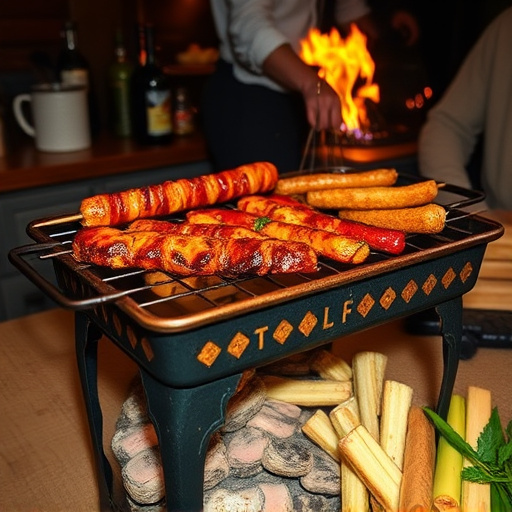
Slow cooking is a time-honored technique that transforms tough rib meat into tender, succulent bites with an unparalleled smoky flavor profile, hallmarks of a perfect smoked BBQ ribs recipe. This method allows the collagen in the ribs to break down slowly over low and consistent heat, resulting in a melt-in-your-mouth texture. For the best results, start by seasoning your ribs generously with a dry rub blend of spices like paprika, garlic powder, salt, and pepper. Then, slowly cook them in a covered pot or smoker at around 225°F (107°C) for several hours until the meat easily separates from the bone.
The slow and steady approach ensures that the ribs retain their juicy goodness, as opposed to faster cooking methods that can dry out the meat. As the ribs cook, the smoke from your BBQ or smoker contributes a rich, smoky aroma and flavor, creating those coveted taste memories associated with traditional smoked BBQ ribs recipes. This meticulous process is key to achieving the classic, mouthwatering ribs experience loved by barbecue enthusiasts worldwide.
Glazing for Shine and Extra Flavor
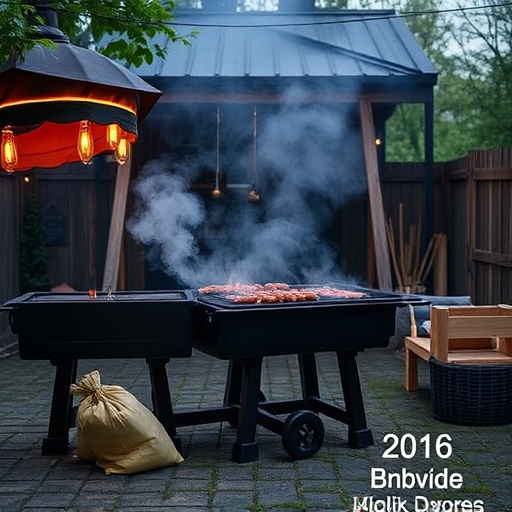
Glazing adds a crucial element to any smoked BBQ ribs recipe, enhancing both the shine and flavor profile. After hours of slow-smoking, a glaze acts as the final touch, transforming your ribs into a mouthwatering spectacle. It not only gives them a glossy appearance but also locks in all the delicious smokey flavors that have been building up during the cooking process.
The perfect glaze can be as simple as a mixture of barbecue sauce, honey, and a touch of mustard, or it can be more complex with ingredients like brown sugar, chili powder, and smoked paprika. Applying the glaze during the last 15-20 minutes of cooking ensures that the sugar caramelizes, creating a sticky, sweet, and smokey coating on each rib. This simple addition can take your smoked BBQ ribs recipe from good to exceptional, leaving folks craving more.
Serving Suggestions: Pairings and Side Dishes
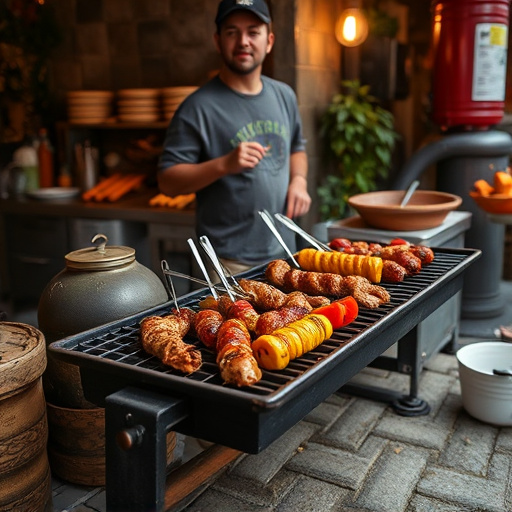
When serving smoked BBQ ribs, think beyond the traditional plate of ribs and sides. The rich, savory smoked bbq ribs recipe lends itself to a variety of pairings that can elevate your dining experience. Consider a simple yet effective combination of creamy macaroni and cheese or garlic mashed potatoes—the starches act as a buffer against the intense flavors, allowing each bite to be enjoyed fully. For a more adventurous option, pair the ribs with a robust salad, like a hearty greens mix topped with pickled onions and a tangy vinaigrette, which can cut through the richness.
Don’t underestimate the power of a well-chosen beverage. A cold, crisp craft beer or a smooth, oaky bourbon can complement the smoky notes in the ribs. Alternatively, offer a selection of sauces on the side—from classic tomato-based BBQ to a tangy apple cider vinegar dressing—allowing diners to customize their bites and explore different flavor profiles.
